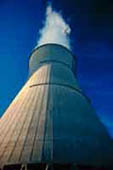[one_full]
 The electrical utility industry is a major provider of energy in the United States. The total amount of electricity sold in the United States in 1998 was 3,240 billion GWh at a cost to the consumers of $218 billion. Electricity generation plants can be divided into seven generic types: fossil fuel, nuclear, hydroelectric, cogeneration, geothermal, solar, and wind. The majority of electric power in the United States is generated by fossil-fuel and nuclear supply systems. The total annual direct cost of corrosion in the electrical utility industry in 1998 was estimated to be $6.9 billion, with the largest amounts for nuclear power at $4.2 billion and fossil fuel at $1.9 billion, and smaller amounts for hydraulic and other power at $0.15 billion, and transmission and distribution at $0.6 billion.
The electrical utility industry is a major provider of energy in the United States. The total amount of electricity sold in the United States in 1998 was 3,240 billion GWh at a cost to the consumers of $218 billion. Electricity generation plants can be divided into seven generic types: fossil fuel, nuclear, hydroelectric, cogeneration, geothermal, solar, and wind. The majority of electric power in the United States is generated by fossil-fuel and nuclear supply systems. The total annual direct cost of corrosion in the electrical utility industry in 1998 was estimated to be $6.9 billion, with the largest amounts for nuclear power at $4.2 billion and fossil fuel at $1.9 billion, and smaller amounts for hydraulic and other power at $0.15 billion, and transmission and distribution at $0.6 billion.
Two different types of nuclear reactors are currently in use in the United States, namely the boiling water reactor (BWR) and the pressurized water reactor (PWR). The fuel for these types of reactors is similar, consisting of long bundles of two to four percent enriched uranium dioxide fuel pellets stacked in zirconium-alloy cladding tubes. The BWR design consists of a single loop in which the entering water is turned directly to steam for the production of energy. The PWR is a two-loop system that uses high pressure to maintain an all-liquid-water primary loop. Energy is transferred to the secondary steam loop through two to four steam generators. The PWR also uses a wet steam turbine. The electric power industry uses three different types of fossil-fuel power plants. The most common and widely used is the pulverized coal-fired steam power plant. Fuel oil can be used instead of coal. Gas turbines are usually smaller units that are used for peak loads and operate only for a few hours per day. Combined cycle plants using both steam and gas turbines are generally used for baseload service, but also must be capable of addressing peak loads. Hydraulic power systems include both hydroelectric and pumped storage hydroelectric plants. In both processes, water is directed from a dam through a series of tapering pipes to rotate turbines that create electricity. In principle, the potential energy held in the dam converts into kinetic energy when it flows through the pipes. The concept behind the development of pumped storage plants is the conversion of relatively low cost, off-peak energy generated in the thermal plant into high value, on-peak power. Water is pumped from a lower to a higher reservoir when low-cost pumping is available from large, efficient thermal plant generation. It is released during periods of high power demand and displaces the use of inefficient, costly alternative sources of generation.
[/one_full]
